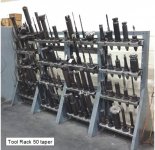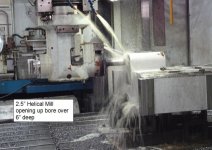I'm after a bit of internet diagnosis please.
IT'S a Haas Tm1, new to me, very low hours, and it works spot on.
But i have noticed a really loud vibration when the spindle is under radial load, but not axial...
The end mill (10mm carbide 3 flt into alu) at 4000rpm, interpolates in fine, but as soon as it starts to expand the pocket and put pressure on the side of the endmill the whole machine sounds like a fog horn is going off.
I have a video below.
Haas tm1 radial load noise - YouTube
Has anyone seen this before? Any idea what it might be?
I don't use the machine much, but as its in my garage I can't have it that loud as neighbours will complain or I'll only be able to run it when they are out at work so I'm going to have to sort it.
Cheers
IT'S a Haas Tm1, new to me, very low hours, and it works spot on.
But i have noticed a really loud vibration when the spindle is under radial load, but not axial...
The end mill (10mm carbide 3 flt into alu) at 4000rpm, interpolates in fine, but as soon as it starts to expand the pocket and put pressure on the side of the endmill the whole machine sounds like a fog horn is going off.
I have a video below.
Haas tm1 radial load noise - YouTube
Has anyone seen this before? Any idea what it might be?
I don't use the machine much, but as its in my garage I can't have it that loud as neighbours will complain or I'll only be able to run it when they are out at work so I'm going to have to sort it.
Cheers



 Are you screwing with him Tom? His machine is making noise while taking a cut so you suggest ~30 sfm in aluminum rather than replace the bearings. He's not running a 6" insert mill hanging out 30" ffs.
Are you screwing with him Tom? His machine is making noise while taking a cut so you suggest ~30 sfm in aluminum rather than replace the bearings. He's not running a 6" insert mill hanging out 30" ffs. chill out man, you can not hide from your neighbour all the time ... try to discuss this situation with him, or he is crazy, and you are afraid that he may go savage on you ?
chill out man, you can not hide from your neighbour all the time ... try to discuss this situation with him, or he is crazy, and you are afraid that he may go savage on you ?




